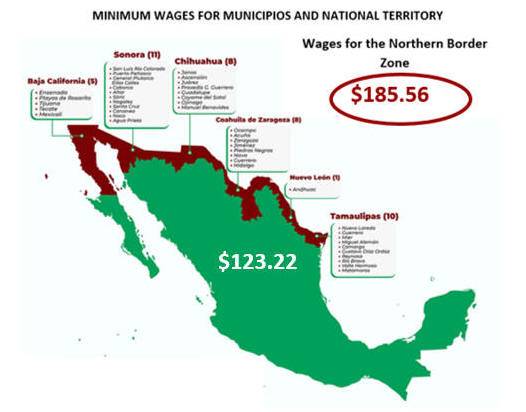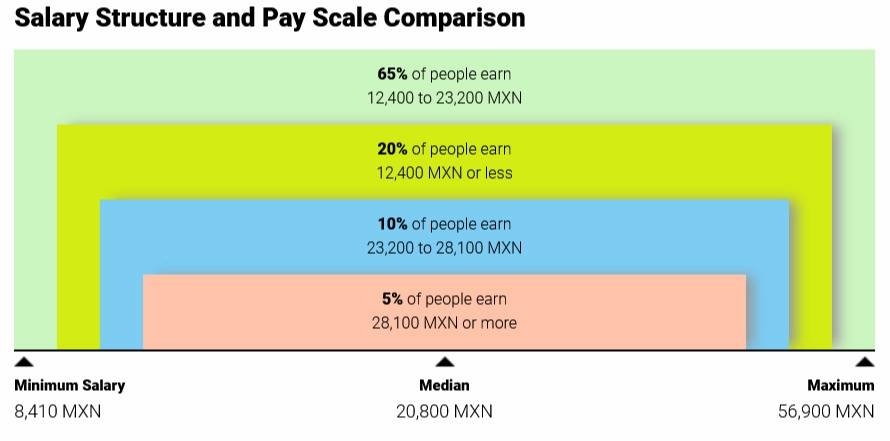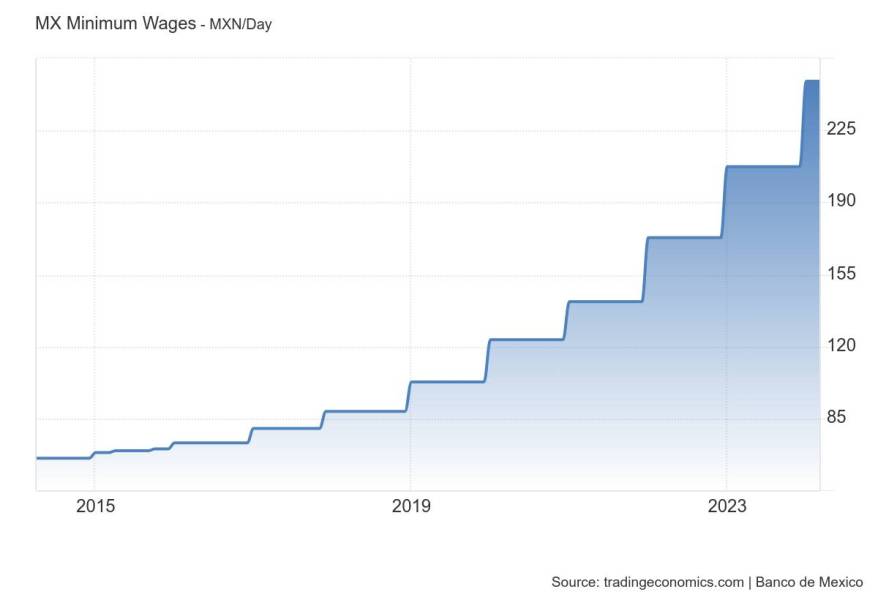Minimum wage in Mexico has surged by 90% since 2018, impacting over 22 million workers and reshaping economic policies. In 2024, wages stood at $248.93 MXN ($14.50 USD) daily, with higher rates in the Northern Border Zone. How do these increases affect businesses, inflation, and economic growth?

Table of contents:
- Introduction
- Historical context of minimum wage in Mexico
- Comparison with other countries
- Current minimum wage in Mexico
- Factors Influencing Minimum Wage Adjustments
- Impact of minimum wage increases
- Future Outlook
The minimum wage in Mexico is a critical economic policy impacting over 22 million workers across the country. It represents the lowest legally mandated remuneration that employers must pay employees for their work. The wage level is determined by the government through the National Minimum Wage Commission (CONASAMI) and is reviewed annually. The minimum wage has experienced significant increases in recent years, with a 90% rise since 2018 as part of government efforts to improve living standards.
As of 2024, the general minimum wage in Mexico stands at $248.93 Mexican pesos per day (approximately $14.50 USD), while in the Northern Border Zone (Zona Libre de la Frontera Norte)—where wages are set higher due to economic factors—the minimum wage is $374.89 MXN per day (around $21.80 USD). These rates reflect ongoing policy adjustments aimed at reducing income inequality and boosting purchasing power.
Mexico’s minimum wage policy varies by geographic regions and specific occupations, recognizing the economic disparities between urban and rural areas. For instance, certain professions such as journalists (earning $415 MXN per day) and nurses ($309 MXN per day) have distinct wage regulations to account for their specialised skills.
This article provides an in-depth analysis of the minimum wage in Mexico, covering its historical background, recent developments, economic implications, and a comparison with global standards. The discussion also explores how factors like inflation, economic growth, cost of living, and international trade agreements (e.g., the United States-Mexico-Canada Agreement – USMCA) influence wage policies. Additionally, future wage outlooks and potential labour reforms are examined to understand their impact on workers, businesses, and the economy.
Historical context of minimum wage in Mexico
The establishment of a minimum wage in Mexico dates back to the early 20th century. Following the Mexican Revolution (1910–1920), the country underwent significant social and political changes, including the introduction of labour reforms. The Mexican Constitution of 1917, particularly Article 123, laid the groundwork for workers’ rights, including the right to a fair wage. This constitutional provision mandated that wages must be sufficient to meet the normal needs of a worker’s family, including education and leisure.
In 1931, the Federal Labour Law was enacted, formalising the concept of a minimum wage. The law established the National Minimum Wage Commission, responsible for determining wage levels based on regional economic conditions. Initially, Mexico implemented a geographically differentiated minimum wage system, recognising the vast economic disparities between urban and rural areas, as well as between different states.

Comparison with other countries
Mexico vs. the United States
The minimum wage in Mexico is significantly lower than in the United States, where the federal minimum wage is $7.25 per hour (equivalent to approximately $58 per day for an eight-hour workday). The wage disparity contributes to labour migration from Mexico to the US in search of better opportunities.
Mexico vs. Latin America
Within Latin America, Mexico’s minimum wage is moderate compared to countries like:
- Argentina: $460 per month
- Chile: $500 per month
- Brazil: $310 per month
Some countries, such as Colombia and Peru, have similar minimum wage levels, while others, like Venezuela, have much lower wages due to economic instability.
Current minimum wage in Mexico
General minimum wage
As of 2024, the minimum wage in Mexico has been set at $248.93 Mexican pesos per day (approximately $14.50 USD per day). This represents a significant increase compared to previous years and reflects the government’s efforts to improve income levels for workers.
Northern border zone
In the Northern Border Zone (Zona Libre de la Frontera Norte), which includes states bordering the United States, the minimum wage is higher to reflect the increased cost of living and economic activity. The wage in this region is $374.89 Mexican pesos per day (around $21.80 USD per day). This special wage policy was introduced to prevent wage disparities and reduce economic migration.
Specific occupational minimum wages
Beyond the general minimum wage, Mexico has specific minimum wages for certain occupations that require specialised skills or training. Some examples include:
- Bricklayers: $256.00 MXN per day
- Plumbers: $272.00 MXN per day
- Nurses: $309.00 MXN per day
- Journalists: $415.00 MXN per day
Factors Influencing Minimum Wage Adjustments
The National Minimum Wage Commission (CONASAMI) is responsible for determining and adjusting the minimum wage in Mexico. The decision is influenced by several factors:
- Inflation rate: One of the primary considerations is the inflation rate, as rising prices affect the purchasing power of workers. Adjustments aim to ensure that wages keep pace with living costs.
- Economic growth: The government evaluates overall economic performance, including GDP growth, employment rates, and industry productivity before setting new wage levels.
- Labour market conditions: Unemployment rates and workforce participation influence wage adjustments. A higher demand for labour often leads to wage increases.
- Cost of living: The cost of essential goods and services, including food, housing, and transportation, is a critical factor in determining fair wage levels.
- Exchange rate and international trade: Given Mexico’s strong trade ties, particularly with the United States and Canada, exchange rate fluctuations and competitiveness in global markets also play a role in wage policies.
- Government policies and social welfare goals: Wage adjustments often align with broader government initiatives to reduce poverty and inequality.

Impact of minimum wage increases
Effects on workers and households
An increase in the minimum wage in Mexico directly benefits low-income workers by improving their earnings and living standards. Higher wages enhance access to healthcare, education, and basic necessities, reducing economic vulnerability.
However, wage increases must be balanced to prevent excessive labour costs that might lead to inflation or job losses in certain industries.
Effects on businesses
For businesses, especially small and medium enterprises (SMEs), higher wages translate into increased operational costs. Some companies may pass on these costs to consumers through higher prices, while others might reduce workforce size or limit hiring to maintain profitability.
Larger corporations, particularly in the manufacturing and export sectors, often adjust through productivity improvements and automation rather than reducing employment levels.
Effects on the economy
A higher minimum wage in Mexico can boost overall consumer spending, as workers with increased earnings contribute more to the economy. This, in turn, can drive economic growth, stimulate demand for goods and services, and encourage investment in local industries.
Conversely, there is a risk of inflation if businesses raise prices to offset labour costs. Policymakers must carefully balance wage increases with economic sustainability.
Future Outlook
The Mexican government has pledged to implement progressive wage increases to enhance living standards and reduce economic inequality. Future wage adjustments are expected to continue, considering factors such as inflation, the cost of living, and overall economic conditions. In addition to wage increases, potential reforms are likely to focus on reducing income disparity, strengthening labour rights, and improving wage enforcement. Efforts to transition informal workers into the formal economy may also be introduced to ensure better wage compliance and worker protections.
Furthermore, Mexico’s participation in international trade agreements, such as the United States-Mexico-Canada Agreement (USMCA), may play a significant role in shaping wage policies. These agreements aim to maintain the country’s competitiveness in global markets while promoting fair labour practices. As economic and political factors evolve, Mexico’s approach to wage regulation and labour rights will likely continue to adapt to both domestic and international influences.
Himani Verma is a seasoned content writer and SEO expert, with experience in digital media. She has held various senior writing positions at enterprises like CloudTDMS (Synthetic Data Factory), Barrownz Group, and ATZA. Himani has also been Editorial Writer at Hindustan Time, a leading Indian English language news platform. She excels in content creation, proofreading, and editing, ensuring that every piece is polished and impactful. Her expertise in crafting SEO-friendly content for multiple verticals of businesses, including technology, healthcare, finance, sports, innovation, and more.


































